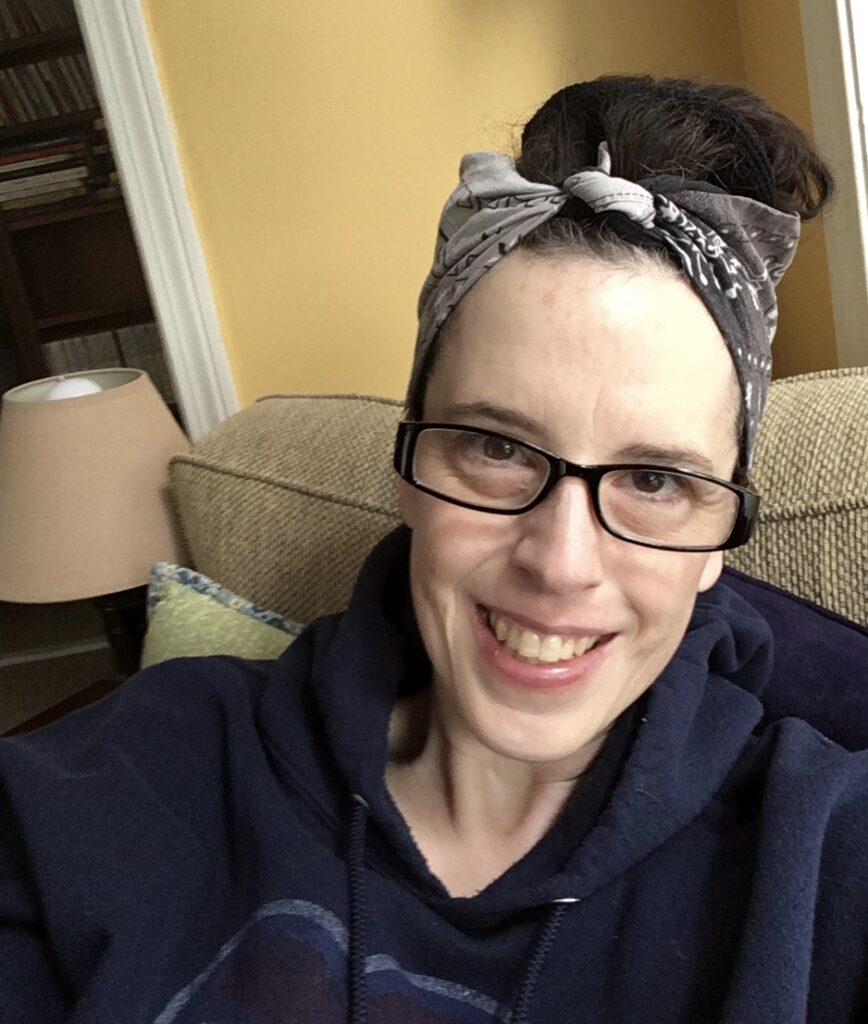It’s been a while since I’ve done a Sjögren’s blog update. That is both a good thing and a bad thing. Good because it means I have been somewhat successful in putting some mental distance between me and this life altering illness, but it is also bad because I am a firm believer in connecting with other Sjögren’s patients and sharing our insights into how to live as well as possible with Sjögren’s.
Recently, I was asked by the Sjögren’s Syndrome Foundation to be part of a group of Sjögren’s patients piloting a new patient website message board. I have checked out other patient message boards, Facebook groups, etc., but I have only really found myself connected to one other particular Facebook group called Sjögren’s Sisters (if you need help finding it, send me an e-mail or message me on Facebook). So, I was really curious about this new project.
I enjoy doing volunteer type stuff for the SSF, but oftentimes I run into problems with committing physically to projects. Kind of ironic, isn’t it? You want to help the non-profit that does good for your illness, but your illness holds you back. But this project is time limited and I never have to leave my couch or bed to help with it. That’s a win for me!
The project has linked me up with eleven or so other Sjögren’s patients and we exchange information regarding living with our illness and the various challenges that come with that. It’s such a great resource. We are still in the trial phase and once we go live, I will definitely share the information on this blog, so stay tuned.
The project couldn’t have come at a better time for me. Sjögren’s has been overwhelming me lately. My body has been overwhelming me lately. And by lately, I mean for about six months. I am experiencing so many symptoms lately and I don’t even know for sure which are autoimmune related and which are not, although my guess is, most of them are related somehow, some way. Because of all the symptoms, I have had to cancel out on commitments a lot more than usual and while I can be a homebody as much as any introvert, I am spending way more time at home and in bed than I would like. Isolation can be a killer for sure.
So this is what has been going on lately in my Sjögren’s world:
Last April my rheumatologist and I decided to try a medication called Orencia. For those of you who don’t already know this, Sjögren’s syndrome does not have a cure. It doesn’t even have any treatment designed to treat it. Instead we have to depend on medications used for other autoimmune illnesses and then pray and hope that we will be lucky enough to have one of them help us.
Orencia (abatacept) is a biologic medication often used to treat RA (rheumatoid arthritis). RA and Sjögren’s have several symptoms in common. For me, the symptoms I needed the most help with at the time were joint/muscle pain and fatigue. I had to get an insurance prior authorization to do the injections at home, but then we found out that my “copay” was going to be $1500/month. $1500!! We then decided that I would drive the four hour round trip to Boston every month to receive an IV infusion of Orencia instead. Cost to me: $30 for gas, tolls, parking, and water. After the first few months of doing this, my local pulmonologist agreed to oversee the infusions at my local, community hospital so thankfully, my commute has gone from four hours round trip to one hour.
I am very medication sensitive. Right after the end of my first infusion, I did have a minor reaction but since then I have had no adverse effects. This is highly unusual for me so I was determined to give this medication a fair shot.
I did notice some improvement about three or four months after starting the infusions. However in the past few months, I have been on and off the fence about how well it works for me. When I saw my rheumatologist right after Christmas, she thought it was helping because my joint swelling was pretty much gone, but I had also just finished three weeks of prednisone so it is hard to say for sure. I do think on most days, Orencia has helped with some of my joint pain, especially in my fingers, wrists, elbows, knees, and toes.
It has not helped my fatigue though and that is where I am really struggling right now. Fatigue has always been a struggle for me with this disease, but I cannot believe how bad it has gotten recently. At the moment, I do think some of it can be attributed to a respiratory infection/cold that I am trying to recover from, but it is definitely more than that. I am not exaggerating when I say that I have to mentally talk myself through even the most basic of tasks because my body just doesn’t want to move. Showering, cooking, even getting from the bedroom to the bathroom to brush my teeth before bed. It’s not than I am necessarily tired and want to sleep all the time. It’s more like my body is stuck in quicksand or I am constantly trying to swim upstream…the entire day that I am awake. Every task and movement is me mentally rallying myself to just get up and do it; convincing myself that nothing can keep me down. But the reality is, I am down. There ARE times where I just can’t do it.
The biggest problem with this?
The less I am out in the world and the less I can do, the more I struggle with my mood. It’s a known fact that people with chronic illnesses have higher rates of depression and so while I am fighting every minute of the day to work through the fatigue, I am also fighting to keep myself upbeat and optimistic.
Muscle pain, dry eyes, dry mouth, nose sores, headaches, and peripheral neuropathy-like symptoms (foot pain) are a daily occurrence lately. The esophageal motility disorder that showed up a few years ago, and then went away, is showing signs that it might become an unmanageable problem again, but I can’t bear the thought of making yet another doctor’s appointment in Boston. So instead, I try to eat foods that are easier to swallow. This week I go to Boston to get my salivary and parotid glands expressed and a few weeks after that, ultrasound of my shoulders because for some reason, they have been getting more and more painful.
I haven’t been able to sit without being in a lot of pain since August and since December, that pain has progressed to my rectum and you can only imagine what kind of havoc that has wreaked on some of my bodily functions. Originally it was thought that it was an orthopedic issue…nope. Then a gastroenterology issue…nope. Well, at least that is what I have been told. I’m not 100% convinced of either. So now it has been brought up that maybe it IS a Sjögren’s related issue after all, specifically a sacral neuropathy. As I write this, I am awaiting a call back from a neurologist in Boston who specializes in these things. I don’t know if he is going to have any answers. Meanwhile, I keep upping my meditation practice to try and deal with the pain and the anxiety over the fact that the tailbone issues may NEVER go away. By the way, if any of you have experience with that, I would appreciate hearing about your experiences and what helped you, if anything.
So what’s a girl to do? It’s like any adverse situation: you fight or you give up. I’d like to say that giving up is not an option, but we all know it is. Luckily for me, right now, it is not. And honestly, oftentimes the only reason that it is not an option is because I know how much I am loved. And I know that I still have work to do in this world; work that is important. In terms of giving up on dealing with my illness and symptoms, that is not an option either. I know that Sjögren’s can be progressive and I am only 45…that’s a lot of years left for things to get worse. So I need to be as on top of things as I can. I will be honest, lately I have thought about what it would be like to just stop all my medications, all the painful procedures, and all the appointments, but like I said, I am loved and I have important work to do.
For my physical body, I employ as many complementary treatments as I can afford and which work. Yoga, massage, exercise, diet, and meditation are the biggies that I can think of. Even if I sometimes feel that these treatments don’t help me physically, they always help me mentally. There is always the option for me to start up yet another course of prednisone, but I am trying to avoid that as long as possible.
My answer right now is to do the best I can. I work as a substitute school nurse and when they call, I try to go into work as much as I can because at the end of the day, I am more than a patient, I am also a nurse and a pretty good one at that. Yes, it’s usually hell getting through the day and yes, I feel like death after work, oftentimes for days, but I know that for me, work is a necessary part of trying to normalize my life, even if it is only for a few hours or days a month.
I try to put myself in situations where I am helping other people. I volunteer for the American Cancer Society, the Sjögren’s Syndrome Foundation, and my church. Sometimes that means going for months without being able to do anything to help at all, but doing whatever little good we can do in this world is so much better than doing nothing at all.
I work very hard at trying to appreciate what I do have and what is going right in my life. It may not look how I envisioned it to look in some aspects, but in many other aspects, life has turned out so much better than I thought. So I am going to keep trudging along and no matter what, always keep the hope.


